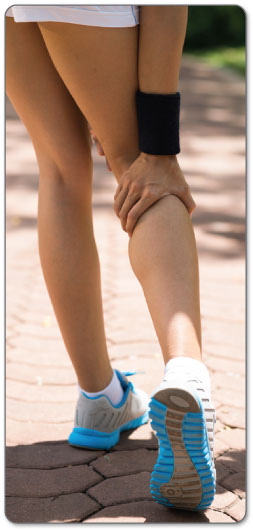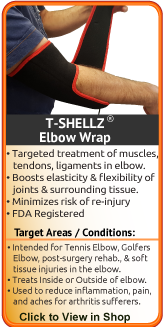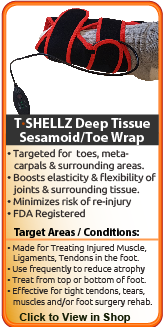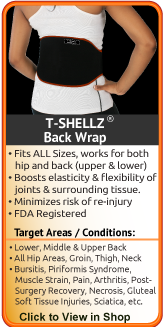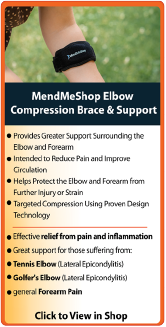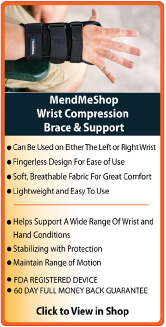Ice vs Heat for Treating Tendon Pain
When dealing with tendon pain it's hard to know what treatment will work best for you. You might be wondering if ice and heat will work for you. Or maybe even which will work better - ice OR heat. Icing and heating are 2 of the most natural treatment options available. Compared to medications, surgery and other treatment methods - icing and heating have been around for centuries and have always been used for soft tissue (muscles, tendons) injury treatments as a means to soothe and heal.
We understand that it can get pretty confusing to figure out what conservative treatment method will work best with all of the treatment options available to you today. To get started, you should think about the benefits you'll get from using these treatments.
What's Better to Treat Your Tendon Injury: Ice or Heat?
Ice and heat are the best treatment combination for you if:
- You want to boost the natural power of pain relief and healing in your body.
- You want to minimize the cost of injections, medications, hospital visits or surgery.
- You want to minimize the time needed for long-term healing (and get back to work quickly)
- You want to reduce the chance of re-injuring your tendon.
- You want to reduce the chance of secondary injuries that long term (chronic) tendonitis can bring.
- You want to control your own treatment and healing at home, on your own time.
- You're looking for a tried, tested, and true method of healing that's been used for centuries and has worked for countless other tendonitis pain sufferers.
Combining cold and warmth is a simple yet effective way to get immediate pain relief and promote long-term healing. In your lifetime you've probably had your mom, family doctor, nurse, surgeon or physical therapist tell you to use ice right after you're injured and something warm from time to time once the swelling's gone down. It's a simple yet very effective way to relieve pain and promote healing in your injured tendon.
If you want to be proactive about properly dealing with your tendon pain, speak to your doctor about adding conservative temperature treatments to your home recovery with AidYourTendon's system using a Cold Compress or Ice Pack, MendMeShop Arnica Pain Cream, and a Localized Enhanced Circulation Device via the TShellz Wrap®.
These tools will help you on your mission to achieve positive results while aiding in the prevention of re-injury and secondary injuries.
Note: If you have an Acute (recent, inflamed) Soft Tissue Injury, Do Not Use Heat.
Your doctor knows that the sooner cold is applied, the quicker you can reduce inflammation and achieve real pain relief. This will help reduce the chance of a much longer lasting chronic injury. Heat and inflammation are a bad mix and should not be used together. Heat is good at the spa - it will help your body relax, but when it comes to an injury that is swollen, it is not a good idea (unless your physician specifically recommends otherwise).
When To Use Cold:
A Cold Compress or Ice Pack work best to relieve pain, swelling and inflammation for new injuries, re-injury and during immediate post surgery recovery. Cold should also be used during the first 24 - 72 hours of the occurance of the injury, combined with resting your injury. Generally speaking, cold is recommended:
- 24 to 72 hours after your initial tendon injury or when you first notice pain and swelling to stop tissue damage at the microscopic level, relieve pain, and decrease swelling.
- After exercise, workouts or activity of any kind to prevent re-injury.
- Before and after surgery during rehabilitation to control pre and post-surgery pain and swelling.
- Anytime you feel swelling in your tendon or nearby muscles have flared up (probably due to activity).
- Anytime you have swelling, sharp throbbing pain or inflammation.
- Any other situation where you need to draw the pain and inflammation out of your tendon and surrounding tissue.
When to use a TShellz Wrap (HEAT):
- When the swelling (and associated pain due to swelling) has been reduced.(usually after applying cold compression to the injury over 24 to 48 hr period).
- BEFORE getting out of bed in the morning. BEFORE going to bed at night.
- BEFORE exercise, workouts or activity of any kind to increase elasticity of joint ligaments & tendons and decrease chance of re-injury.
- AFTER surgery (once the skin wound has healed over and your physician approves) to boost blood circulation, helping surgically repaired tissues rebuild for long-term health and minimize scar tissue growth at the surgery location.
- Anytime you feel your tendon may have stiffened up, is tight and your mobility is reduced causing you more pain.
- Anytime BEFORE you feel you might undertake activity that will put significant strain on the injury area.
- Any other situation where you need to increase blood flow to your injury to relax soft tissue in your joint, relieve trigger point pain / spasms, prevent re-injury and enhance flexibility of soft tissue.
Here Are A Couple Of Examples For When To Use Cold (Ice) Or Heat:
You have a achilles tendonitis injury that's been on-going for quite some time.
You're having a "good day" (your injury is feeling fine) and decide to head out for some grocery shopping. You realize afterwards that was a bad idea because you are experiencing more pain in the back of your heel at the point of insertion.
You have aggravated the injury so you should use COLD on your achilles to stop further damage to your tendon and help ease the pain. Consider adding a heat treatment later on in the injury cycle once the swelling (and much of the pain) is gone.
You have a painful case of tendonitis in your shoulder.
You're in the kitchen making a cup of tea and reach in your cupboard to get a mug. You forgot about your injury because it's no longer hurting, but oops... Reaching for that mug just reminded you about your shoulder injury with a sharp pain / twinge. You stop and ask someone else to retrieve the mug for you (you stopped the activity that will cause more inflammation).
The pain was temporary and if there is no inflammation, NO cold compression is needed.. In this case heat (via the Shoulder TShellz Wrap) should be used to encourage more blood flow in the area while also helping improve flexibility in the shoulder.
Use cold after any sort of activity causes you on-going pain.
When Should You Use Heat for Your Tendon?
The application of a TShellz Wrap is a heat treatment, designed to increase blood flow circulation, maximizing the body's ability to stimulate healing. The heat effect is also very beneficial for soft tissue flexibility, helping minimize risk of re-injury during the injury recovery period. Be aware, however, that heat applications should only be used once inflammation has been reduced.
A TShellz Wrap should not be used directly after an injury, as you must wait for swelling to drop. TShellz Wrap® treatments should not be started for a least 6 weeks after surgery because inflammation levels will be very high as the healing process starts over again. Any use of TShellz Wrap should also be combined with gradual movement to stretch out your joint and increase range of motion.
If you have a chronic tendon injury that won't seem to go away, we recommend use of a TShellz Wrap before activity to loosen up soft tissue in the joint (making it more flexible). This treatment is shown to increase the elasticity (flexibility) of the soft tissue in and around the treatment area, making it more pliable for activity and less likely to re-injure (important).
Sometimes we feel pain while doing a certain activity - should you still use a heat treatment like the TShellz Wrap? A treatment in the morning before you start your day or before activity can help boost blood-flow and reduce risk of further strain or injury. Use cold part-way through your day after you have been active so you can decrease pain and inflammation from the flare up.
Using a TShellz Wrap® is a good long-term plan because it will help stimulate blood flow (vasodilation) and can also be used on a preventive basis to relax constricted tissue. The use of a TShellz Wrap® indirectly enhances the local blood circulatory system, increasing the supply of oxygen and nutrients - the energy your tissue needs to flourish.
With regular use of the TShellz Wrap:
- Your pain will be reduced.
- In most cases, your body's healing process will be accelerated (due to enhanced blood circulation) with reduced potential for re-injury*.
- Soft tissue in the treatment area will have a enhanced range of motion and increased extensibility of collagen tissue. (Chapter 9 of "Therapeutic Heat and Cold", 4th edition.
(amazon.com link - Ed. Justus F. Lehmann, M.D., Williams, and Wilkin)
Our high quality wraps are registered with the FDA as medical devices which meet high manufacturing standards.
How to Use Ice and Heat to Relieve & Treat Your Tendon

When it comes to using ice and heat for treating tendonitis, it's important to keep in mind that both ice AND heat are very effective ways to relieve pain and heal. Most people will think one is better over the other from their own experience or what a doctor / physical therapist has previously told them.
The only difference between using ice and heat is that 1 is better for you at a specific time in your healing cycle. Ice is used first, right when you get your injury, to decrease pain / swelling and inflammation. Once swelling has reduced, we then focus on heat based treatments to increase blood flow circulation in the area which will stimulate the body's healing response.

Both Ice and Heat temperatures have their own unique benefits and when used together they provide a powerful advantage to long-term healing. You may already know that ice or heat feels better on your injured tendon, and this could influence your decision too.
The bottom line is that ice and heat are exceptional, natural pain relievers and healers for your tendon injury.
There are cases where some tendon injuries will respond better to 1 temperature over the other. We want to help clear up the confusion so you know which is better (cold vs heat) and how to get the most from your treatment at home.
Part 1: Cold
Ice / Cold as Pain Relief for Your Tendon Injury
COLD (ice) is used to treat injuries or conditions that are red, hot, inflamed, swollen and suffering from tissue damage (a tear or recovering from surgery). Cold is a natural / organic pain reliever that numbs pain right at the source of your injury. While doing this the cold also stops tissue break-down and reduces the amount of scar tissue forming (this is very important after surgery).
When cold is applied to a tendon injury, all of the soft tissue in the treatment area will squeeze on the veins to slow down blood flow. This in turn clamps down on the amount of fluid leaking into your injured tissue, decreasing your swelling. This is why cold is used immediately to treat newer soft tissue injuries or re-injuries. The cold slows down your body to stop the amount of damage happening to your tissue while also helping decrease swelling. This cold also has a nice side benefit of numbing the nerves in and around your soft tissue, thereby decreasing your pain.
In the medical world this is something called 'Vasoconstriction'.
Cold can Make Your Tendon Injury Worse - How?
Applying cold can restrict blood flow and stiffen / tighten soft tissue. Cold is NOT a good treatment method for your tendon when the tissue is already tight and constricted, because the cold will just stiffen the tissue further and increase the risk of strain/microtearing during movement. This is especially true if you're suffering from any cramping or spasming in the affected joint. Cold applied in areas of muscle cramps or spasms will only make the muscle cramp or spasm even more, again putting more pressure on your injured tendon and increasing the pain.
Instead, use a treatment that will increase blood flow, like the TShellz Wrap®, to relieve tightened and constricted tendons and muscles. The heat from the TShellz Wrap® will help make tissue in the treated area more elastic and pliable for activity (reaching, athletics, or working). This means it will be less likely to strain during exertion.
When To Use a Cold Compress or Ice Pack For Your Tendon
Cold works best to relieve pain, swelling and inflammation for new injuries, re-injury and during immediate post surgery recovery. Cold should also be used during the first 24 - 72 hours of treatment, combined with resting your injury.
If you've been suffering for some time with a chronic tendon injury you should only use cold after activity causes you more pain or triggers more inflammatory response symptoms (red, hot, inflamed, swollen). This would be when your the area around your tendon starts to hurt at the end of the day after you've been active or performing tasks that have put friction or stress on your injured tendon. When used at this time, cold compression becomes a natural / organic pain reliever, treating the site where you feel the pain.
Sometimes we feel pain while doing a certain activity - should you still use cold? Too much cold can reduce your ability to heal correctly, because cold is a short term pain reliever not a deep tissue healer.
A cold treatment application slows nerve and tissue function - reducing swelling that blocks blood vessels from doing their job. This is important because once blood vessels are blocked or damaged, they can no longer carry oxygenated blood through the tissue and so, they begin to break down. Without cold compression, tissue break-down and damage continue as this tissue cannot access the oxygen it relies on to survive. By limiting the amount of damage done to your tendon, you also limit the amount of healing that needs to occur. This is a very important step to heal soft tissue injuries faster and with less pain!
Part 2: Heat
Heat for Tendon Recovery
HEAT is used after you've reduced your swelling / inflammation and the sharp pain is less intense (you have more of a dull / nagging ache and stiffness / tightness). Warming up your muscles and tendons is a natural way to encourage healing (by increasing blood flow and minimizing risk of re-injury due to increased soft tissue flexibility). Increasing the temperature of soft tissue results in increased blood flow circulation as the body responds to heat by increasing blood flow. It's the blood in your body that will bring oxygen, nutrients and water (basically energy) to your injured soft tissue to help with healing.
When heat is applied to a tendon injury, your veins will expand, allowing more blood flow through; this in turn relaxes your soft tissue, making it more flexible and elastic. This is why heat is used on older (chronic) injuries and spasms / cramps - to loosen tight tissue and bring in the blood flow needed for healing. Your body will try to heal itself after experiencing a soft tissue injury; increasing your blood flow through heat, in a large majority of cases, will help augment this natural process.
Doctors usually call this process 'Vasodilation'.
Heat can Make Inflammation, Swelling and Newer Injuries Worse - How?
When we injure ourselves, we start healing right away. The body will naturally raise the temperature at the site of the injury resulting in the inflammatory response (redness, heat sensation, inflammation and swelling). This 'fake fever' leaks blood flow to the area to cool it down and start the healing process.
Adding 'heat' to your injury when it's already inflamed and tender may make your body think there's a new threat to your tissue and increase the pain in order to get you to stop. For some people applying heat on inflamed / swollen tissue will cause the injury to swell-up even more (as much as 3 times larger than normal). You'll feel even more pain as the pressure builds on top of your injury.
Heat is NOT a good treatment method for inflamed injuries, new injuries (within the first 24 to 72 hours), right after surgery or right after a re-injury. In these cases, heat should be applied later on in the healing cycle. In the meantime, use a Cold Compress or Ice Pack to decrease swelling and inflammation induced pain.
Another Tendonitis Ice vs Heat Example:
After spending 3 years as a hardwood floor installer, you are having difficulty.
Over the last couple months you have noticed that your knees are getting harder to bend. It is even starting to affect your ability to walk. After seeing your physician, she has informed you that you have contracted patellar tendonitis, commonly known as "jumper's knee". It is not infected (septic) and you have been told to take some time off to rest and heal up the tendon before it gets worse.
You have switched jobs until the problem goes away (stopped the cause of the problem). Use a Cold Compress or Ice Pack as a natural pain-reliever and for inflammation reduction. The cold compression will also decrease the amount of damage being done to the knee.
Once pain and inflammation have reduced significantly, we recommend the of use of the Knee TShellz Wrap for increasing blood circulation in the area while also helping reduce the risk of worsening the re-injury via the heat effect. As long as there is no inflammation, use TShellz Wrap® treatments before activity or if you notice stiffness to warm up soft tissue in the knee.
Keep using TShellz Wrap® treatments before activity and when you notice stiffness to 'warm up' your tissue and stimulate blood flow.
How to Use Consistent Deep Tissue Stretching for Improved Tissue Flexibility & Health
For many people, the treatment won't just end there. Stretching is also an important part of of deep healing - and it's the final step needed when healing your injury with conservative treatment methods.
You would be surprised by how many people there are that don't understand the importance of stretching when recovering from a tendon injury. Before returning to full activity after tendonitis, physical therapists prescribe gentle stretching of the affected area... This is because stretching is a major component of healing soft tissue. Consistent stretching is one of the only solutions available to break up scar tissue that forms on your tendon & muscles as it heals.
Stretching soft tissue after a recent treatment with the TShellz Wrap is the best way to gain the stretching you need for recovery while minimizing the risk of re-injury. This is due to the effect that heat has on soft tissue - it elongates and increases flexibility of soft tissue which is exactly what you want when you are stretching.
There is a Unique Formula Used for Recovering from Tendonitis...
We're going to let you in on a key piece of information... There is a 3-Step Formula that is adhered to in Nearly all cases of soft tissue injury recovery:
Step 1 - Warm Up Your Injury Site
For this 1st step PTs will use heat, manual manipulation, deep tissue massage, ultrasound or a warm bath to warm up your injury site. The goal during this first step is to increase healthy blood flow circulation and relax your affected tissue.
'Warming up' your injury will increase the elastic-nature of your tissue fibers making it much easier to stretch and when needed, hold the stretch. This will also extend the amount that you will be able to stretch your injury site.
Warm it Up At Home
Use a TShellz Wrap® for 10 to 15 minutes at least half an hour before stretching your injury. A TShellz Wrap will indirectly increase localized blood flow while simultaneously warming up and relaxing tissue in the treatment area. When soft tissue becomes more elastic and pliable, there is a reduction in stress which lowers your risk of experiencing a new strain or re-injury. This will allow for pain reduction and ease of movement when you're stretching and/or exercising.
Continued daily treatment with a TShellz Wrap® will also deliver much-needed oxygen and nutrients to tissues in the area. An increased blood flow will boost your body's own natural healing capability while minimizing setbacks due to further injury in your recovery.
Step 2 - Stretch Your Injury
The main goal of PT is to exercise (stretch out) the affected area to improve flexibility and range of motion. After the PT has warmed up your injury site, they'll get you to do a series of exercises that are focused on stretching out your tissue.
These exercises will be focused on "unfreezing" the joint and force soft tissue to both strengthen and become more elastic. Sometimes cardiovascular exercise, like using a stationary bike or treadmill, will be recommended under the supervision of your PT.
Why are tendon injuries so hard to over come? In two words - scar tissue.
Tendon and muscle tissue is meant to be soft and flexible, ready to work, and move extreme forces in everyday activities. Damaged soft tissue will heal with scar tissue - little tiny band-aids that overlap each other to bind damaged soft tissue together. With the added scar tissue the tendon becomes more rigid, less able to stretch as much as it did before. If you're suffering with scar tissue now you may feel the effects with stiffness, tightness, weakness and tiredness at the location of the tendon injury site.
Scar tissue can form fast to bring together the edges of a tissue tear, but working fast doesn't mean that the job's done right. When scar tissue forms it doesn't come together as neatly as regular (healthy) tissue would. Scar tissue fibers will lay down over top of your tear in a cluttered, messy and jumbled up way. Most important of all - scar tissue is very inelastic, meaning that scar tissue will seize you up.
Imagine throwing a bunch of drinking straws in the air... When those straws hit the ground they'll land in a random, unorganized way. It even seems silly to think that those straws could land perfectly straight and all in the same direction. Stretching helps to organize the scar tissue, increasing the strength of this tissue so it's more like the weave of a basket.
Step 3 - Cool Down Your Tendon Injury
Toward the end of your appointment your PT may introduce the application of a Cold Compress or Ice Pack, acupuncture, or TENS to relax your tissue after the intense stretching and exercise.
Use a Cold Compress or Ice Pack after stretches and exercise - or really whenever you feel pain. This will help prevent full-blown inflammation from returning after your stretching regimen.
Our Tendon Formula Works!
It may seem hard to believe, but our TShellz Wraps® home treatment devices & accessory products will assist you in recovering from your injury by reducing your swelling and inflammation induced pain, maximizing blood flow where it's needed most, and increasing the flexibility / range of motion in the area - especially when combined with consistent stretching.
Here at AidYourTendon we pride ourselves in helping you with your healing and recovery process. Everyone at AidYourTendon has tested and used the products, finding solutions to conditions that do not fit into the norm. This dedication to our customers and our products goes hand-in-hand with our guarantees to you as a customer:
- Guarantee #1 - Use your products diligently for up to 60 days and you will experience a significant reduction in pain. If not, I encourage you to send back the items for a 100% refund.
- Guarantee #2 - You will not be left in the dark after purchasing any product from us. AidYourTendon Advisers and Product Specialists are available Monday to Friday by toll free phone 1-866-237-9608 or email to answer your questions or concerns.
- Guarantee #3 - Your order is guaranteed to be shipped within 24 hours on every business day.
- Guarantee #4 - All purchases receive a one year, full replacement warranty with guaranteed, prompt service.
- Guarantee #5 - You could save hundreds of dollars and possibly more, by utilizing our products, and getting back to work sooner.
Learn More About Tendon Injuries & TreatmentsI want to learn more about Post-Surgery Recovery I want to learn more about TShellz Wrap® Circulatory Boost I want to learn more about Ice & Heat: Which Is Better For Treatment? I want to learn more about Tendonitis Treatments I want to learn more about Tendonitis Surgery
FREE SHIPPING ON ALL PRODUCTS CURRENTLY ENABLED
60 DAY TRIAL PERIOD
During your recovery, you will probably have to modify and/or eliminate any activities that cause pain or discomfort at the location of your soft tissue injury until the pain and inflammation settle. The more diligent you are with your treatment and rehabilitation, the faster you will see successful results!
| 